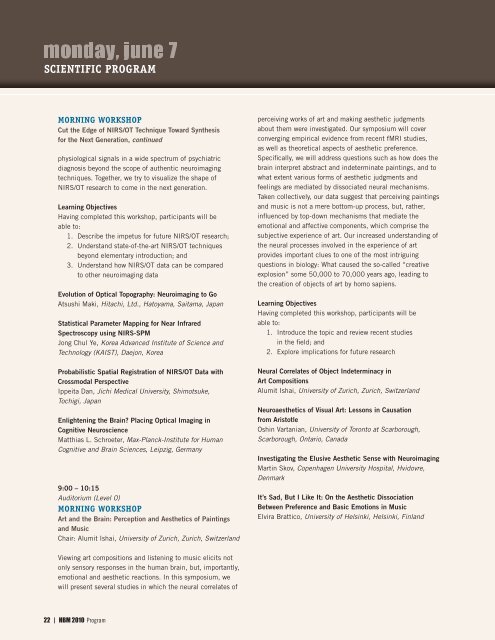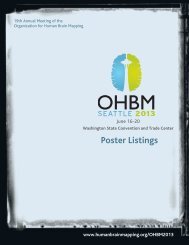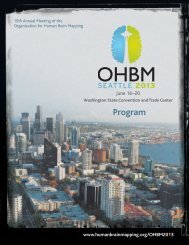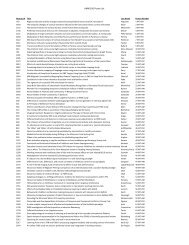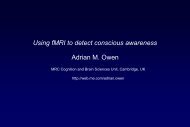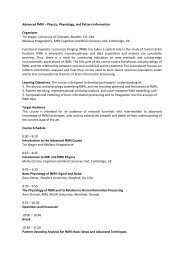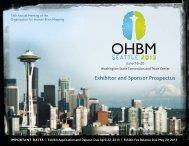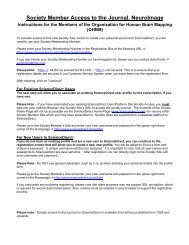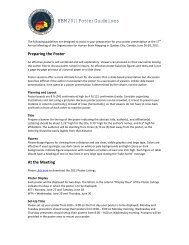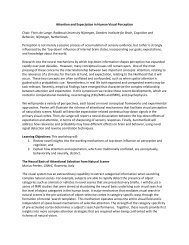HBM2010 - Organization for Human Brain Mapping
HBM2010 - Organization for Human Brain Mapping
HBM2010 - Organization for Human Brain Mapping
Create successful ePaper yourself
Turn your PDF publications into a flip-book with our unique Google optimized e-Paper software.
SCIENTIFIC PROGRAM<br />
MORNING WORKSHOP<br />
Cut the Edge of NIRS/OT Technique Toward Synthesis<br />
<strong>for</strong> the Next Generation, continued<br />
physiological signals in a wide spectrum of psychiatric<br />
diagnosis beyond the scope of authentic neuroimaging<br />
techniques. Together, we try to visualize the shape of<br />
NIRS/OT research to come in the next generation.<br />
Learning Objectives<br />
Having completed this workshop, participants will be<br />
able to:<br />
1. Describe the impetus <strong>for</strong> future NIRS/OT research;<br />
2. Understand state-of-the-art NIRS/OT techniques<br />
beyond elementary introduction; and<br />
3. Understand how NIRS/OT data can be compared<br />
to other neuroimaging data<br />
Evolution of Optical Topography: Neuroimaging to Go<br />
Atsushi Maki, Hitachi, Ltd., Hatoyama, Saitama, Japan<br />
Statistical Parameter <strong>Mapping</strong> <strong>for</strong> Near Infrared<br />
Spectroscopy using NIRS-SPM<br />
Jong Chul Ye, Korea Advanced Institute of Science and<br />
Technology (KAIST), Daejon, Korea<br />
Probabilistic Spatial Registration of NIRS/OT Data with<br />
Crossmodal Perspective<br />
Ippeita Dan, Jichi Medical University, Shimotsuke,<br />
Tochigi, Japan<br />
Enlightening the <strong>Brain</strong>? Placing Optical Imaging in<br />
Cognitive Neuroscience<br />
Matthias L. Schroeter, Max-Planck-Institute <strong>for</strong> <strong>Human</strong><br />
Cognitive and <strong>Brain</strong> Sciences, Leipzig, Germany<br />
9:00 – 10:15<br />
Auditorium (Level 0)<br />
MORNING WORKSHOP<br />
Art and the <strong>Brain</strong>: Perception and Aesthetics of Paintings<br />
and Music<br />
Chair: Alumit Ishai, University of Zurich, Zurich, Switzerland<br />
perceiving works of art and making aesthetic judgments<br />
about them were investigated. Our symposium will cover<br />
converging empirical evidence from recent fMRI studies,<br />
as well as theoretical aspects of aesthetic preference.<br />
Specifically, we will address questions such as how does the<br />
brain interpret abstract and indeterminate paintings, and to<br />
what extent various <strong>for</strong>ms of aesthetic judgments and<br />
feelings are mediated by dissociated neural mechanisms.<br />
Taken collectively, our data suggest that perceiving paintings<br />
and music is not a mere bottom-up process, but, rather,<br />
influenced by top-down mechanisms that mediate the<br />
emotional and affective components, which comprise the<br />
subjective experience of art. Our increased understanding of<br />
the neural processes involved in the experience of art<br />
provides important clues to one of the most intriguing<br />
questions in biology: What caused the so-called “creative<br />
explosion” some 50,000 to 70,000 years ago, leading to<br />
the creation of objects of art by homo sapiens.<br />
Learning Objectives<br />
Having completed this workshop, participants will be<br />
able to:<br />
1. Introduce the topic and review recent studies<br />
in the field; and<br />
2. Explore implications <strong>for</strong> future research<br />
Neural Correlates of Object Indeterminacy in<br />
Art Compositions<br />
Alumit Ishai, University of Zurich, Zurich, Switzerland<br />
Neuroaesthetics of Visual Art: Lessons in Causation<br />
from Aristotle<br />
Oshin Vartanian, University of Toronto at Scarborough,<br />
Scarborough, Ontario, Canada<br />
Investigating the Elusive Aesthetic Sense with Neuroimaging<br />
Martin Skov, Copenhagen University Hospital, Hvidovre,<br />
Denmark<br />
It’s Sad, But I Like It: On the Aesthetic Dissociation<br />
Between Preference and Basic Emotions in Music<br />
Elvira Brattico, University of Helsinki, Helsinki, Finland<br />
Viewing art compositions and listening to music elicits not<br />
only sensory responses in the human brain, but, importantly,<br />
emotional and aesthetic reactions. In this symposium, we<br />
will present several studies in which the neural correlates of<br />
22 | HBM 2010 Program


